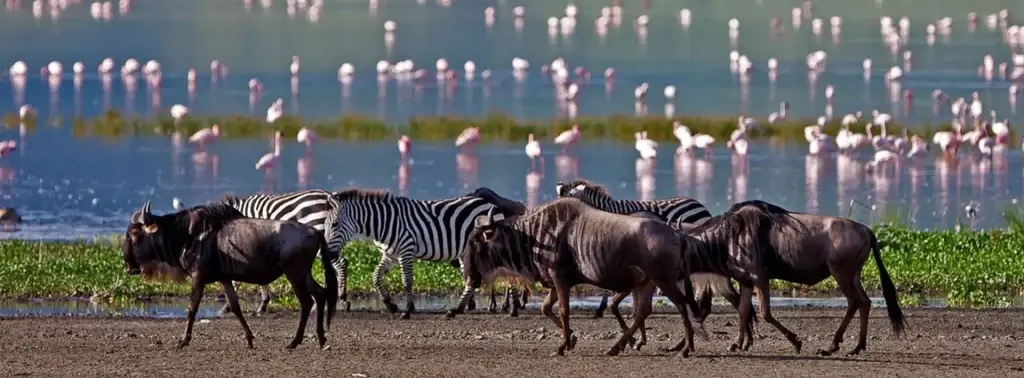Manyara National Park
Manyara national park

Lake Manyara National Park is a captivating destination within Tanzania’s Northern Circuit, renowned for its diverse ecosystems, dramatic landscapes, and vibrant wildlife. Stretching from the base of the Great Rift Valley escarpment to the shores of Lake Manyara, this park offers a unique combination of habitats that provide a home for an array of flora and fauna.

Overview of Manyara National Park:

Lake Manyara National Park is a captivating destination characterized by its dramatic landscapes, rich biodiversity, and diverse ecosystems. Whether observing the iconic flamingos on the lake, spotting the elusive tree-climbing lions, or exploring the lush forest and expansive savanna, the park offers a unique and memorable safari experience. Its combination of habitats supports a wide range of wildlife, making it a vital part of Tanzania’s Northern Circuit and an essential stop for nature lovers and wildlife enthusiasts.
Geography and Landscape:
Lake Manyara.
- Characteristics: Lake Manyara is a shallow, alkaline lake that varies greatly in size depending on the season, covering about 230 square kilometers (89 square miles) during the wet season and shrinking considerably during the dry season.
- Importance: The lake is a critical habitat for numerous bird species, especially flamingos, which come in large numbers to feed on the algae that thrive in its waters.
Forest:
- Types: The park features a mix of evergreen forest and lush, dense woodland. Dominant tree species include the giant fig tree, mahogany, and various species of acacia.
- Biodiversity: The forest provides vital shelter and feeding grounds for a variety of mammals, birds, and insects. It also plays a crucial role in supporting the park’s complex ecological network.
Savanna and Grasslands:
- Location: These areas lie between the forested regions and the lake, offering open landscapes where herbivores graze and predators roam.
- Vegetation: Dominated by grasses and scattered acacia trees, these savannas are crucial for grazing animals and are interspersed with patches of woodland.
Rift Valley Escarpment:
- Features: The escarpment forms a dramatic backdrop to the park, rising steeply from the lake. It offers panoramic views and contributes to the park’s varied climate and microhabitats.
- Impact: The escarpment influences local weather patterns, creating a diverse range of environments from dry savanna to lush forest.
Activities and Attractions
- Game Drives: Exploring the park’s diverse habitats via game drives offers opportunities to see a wide range of wildlife, including both mammals and birds.
- Birdwatching: Lake Manyara is a birdwatcher’s paradise, with its lake and surrounding areas providing habitat for numerous species, particularly during migration periods.
- Scenic Views: The viewpoints along the Great Rift Valley escarpment offer breathtaking vistas of the lake and the surrounding landscapes, making for excellent photography opportunities.
Conservation and Challenges
- Conservation Efforts: The park plays a crucial role in the conservation of its unique ecosystems and wildlife. Efforts include habitat preservation, anti-poaching measures, and community engagement.
- Challenges: Lake Manyara faces challenges such as habitat degradation due to human activities and the impacts of climate change, which affect the lake’s water levels and biodiversity.
Facts about Manyara National Park
- Established: 1960
- Size: Approximately 330 square kilometers (127 square miles), including the lake which covers around 230 square kilometers (89 square miles).
- Location: Northern Tanzania, along the western edge of the Great Rift Valley.
- Elevation: Varies from 950 meters (3,117 feet) to 1,500 meters (4,921 feet) above sea level.
- Climate: Tropical climate with a rainy season from March to May and a dry season from June to October.
Most common animals
Mammals:
– African Elephants
– Tree-Climbing Lions
– Masai Giraffes
– African Buffaloes
– Hippos
– Warthogs
– Blue Monkeys
– Black-and-white Colobus Monkeys
– Plains Zebras
– Spotted Hyenas
Birds:
– Lesser Flamingos
– Greater Flamingos
– African Fish Eagle
– Great White Pelican
– Black-collared Lovebird
– White-backed Vulture
– Red-billed Hornbill
– Yellow-billed Stork
